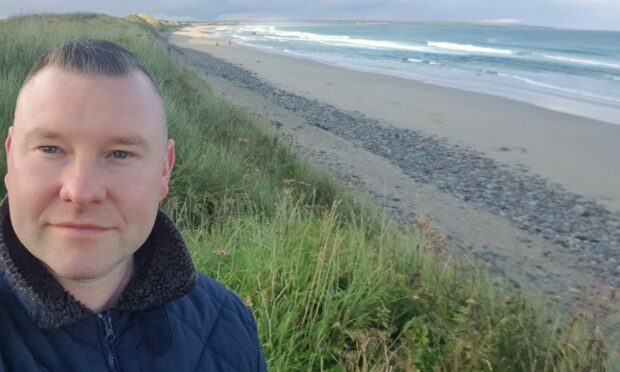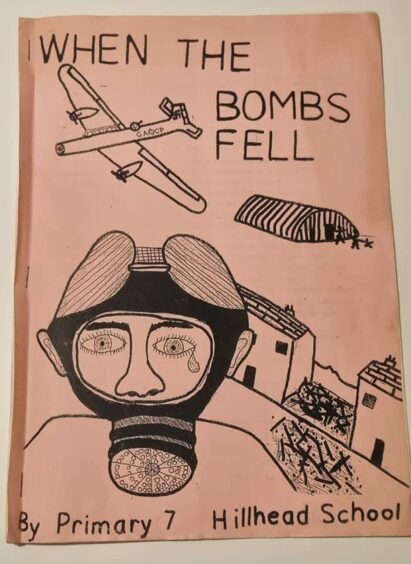Aaron Mullins found a handmade book written in 1989 by Primary Seven pupils of Hillhead Primary School.
‘When The Bombs Fell’ captures first-hand accounts of the Wick bombings during the Second World War.
The far north town was a frequent target for German bombs due to its strategic harbour and airport.
The Hillhead Primary School book is now more than three decades old. It’s thought the school created it as a fundraiser but it’s not known how many copies are left.
Though visibly aged, it’s still in remarkably good condition and gives a fascinating insight into a community ripped apart by war.
It’s inspiring stuff for Aaron, who is now a writer himself. Today he lives in Troon, but he grew up in Wick and has fond memories of the town.
Aaron plans to donate the book to Wick Heritage Centre so that it’s “back amongst the community where it belongs”.
Treasure in a suitcase
Aaron was raised by foster parents in Wick’s Dunnett Avenue, just a few streets away from the site of one of the Second World War bombings.
His foster mother sadly passed away in the summer, so Aaron returned to his childhood home to clear out her things.
“I was surprised to find she kept everything, and discovered a number of treasures that she had preserved for 30 years or more,” he says.
“I attended the North School and was looking through a bag of old jotters in the attic, when I found this book.”
Aaron decided to share pictures of the book on Facebook, seeing it as an important piece of Caithness heritage.
The book has its beginnings in an oral history project for the children of Hillhead Primary School (replaced today by Noss primary).
The P7 pupils interviewed their grandparents, neighbours and community members and gathered all their stories into the book.

‘When The Bombs Fell’ recalls two great tragedies that befell the town.
On 1 July 1940, a German plane dropped two bombs, most likely targeting the harbour.
Instead, the bombs landed on civilian homes in nearby Bank Row. The effects were devastating. Children on their school holidays were out playing on the street, and there was no siren to warn them.
The bombing claimed the lives of 15 people, including seven children, two of them sisters.
‘Something dreadful had happened to my body’
Just three months later, more civilian lives were lost on Hill Avenue, near the airport.
The Hillhead pupils interviewed a Mr George Cameron, whose home was completely destroyed in the blast. Mr Cameron was just 14 at the time.
He told the Hillhead pupils he had put up the blackout blinds at 6pm and was playing with his toy aircraft. His sister Betty, 10, was knitting by the fire and his brother John, 6, playing with bricks.
An extract from the Hillhead School book reads:
“Just at that, I felt I’d gone to sleep and something dreadful had happened to my body. There was a great big bang and clattering of pots and pans and furniture. I felt myself being flung into the air and when I came down I was only half conscious, but I could just lift my hand to my head.
“I felt something wet as if it was blood or water – I don’t know what it was.”
George and his mother survived, but John, Betty and the family’s lodger Mrs Dyer, 20, were all killed.
George’s powerful account was no doubt moving for the young pupils of Hillhead. They would all have played in the area of the bombing, and in 1989 the memories would be quite fresh for many in the community.
It also struck a personal chord for Aaron.
“I found the story about the Hill Avenue bombing fascinating because I played on that street all the time as a child, just up the road from my house at the time,” he says.
“From school projects at the North School I knew Caithness had been bombed, but reading now about the extent of it is quite shocking.”
Bringing people together
Aaron has many memories of his childhood in Wick, which often feature in his own writing.
Two years ago, he published a bestselling book of Caithness stories: ‘Mysteries and Misadventures: Tales from the Highlands‘.
Aaron admits the Hillhead School book has struck a chord with him, and he feels inspired to write more stories based on these true accounts.
“To be able to hear these first-hand stories from people who lived in Caithness at the time is a rare treat,” he says. “It’s also lovely to help others rediscover the stories of their grandparents and great-grandparents, forever captured in a wonderful school project.
“Recent years have been tough on a lot of families. I think these stories remind us that our communities, family and friends have persevered through tough times before.
“Rediscovering our shared heritage can bring us together once again.”
Are you one of the 1989 pupils who contributed to the book? You can share your memories at schoolsandfamily@pressandjournal.co.uk
More from the Schools & Family team
Halloween on a budget? Look no further than your local library




Conversation